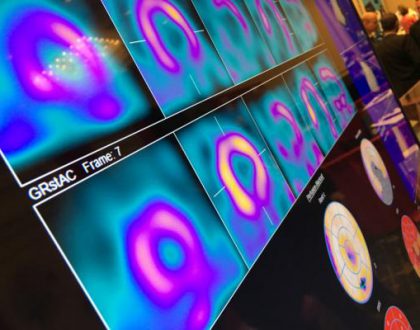Nuclear Imaging Moves Toward Digital Detector Technology
Nuclear imaging technology for both single photon emission computed tomography (SPECT) and positron emission tomography (PET) have made advancements in the past couple years. The main drivers for this have been a movement to digital imaging detectors to improve image quality and address radiation dose concerns, reimbursement and radio-tracer supply issues. Other advancements have come in the areas of software to improve image reconstruction quality, offer better clinical qualification and analytics data.
“We have been practicing nuclear cardiology since the late 1970s, so people think of it as a stable and well-established modality, but if you look at the past five years, there has been a tremendous amount of advance in nuclear cardiological techniques,” said Prem Soman, M.D., Ph.D., director of nuclear cardiology at the Heart and Vascular Institute, University of Pittsburgh, and president of the American Society of Nuclear Cardiology (ASNC). “We have a whole new generation of SPECT cameras, we are expanding our imaging applications, we have made great strides in reducing our radiation dose, and PET is becoming more widely used, so I am very excited about the future of cardiac nuclear imaging.”
He explained one of the biggest advances in the last few years is the introduction of SPECT cameras using digital cadmium zinc telluride (CZT) detectors. These replace the old photomultiplier tubes (PMTs) that have been the industry standard for decades. CZT detectors are smaller to decrease the size of SPECT systems.
Philips Healthcare‘s Vereos Digital PET/CT is a fully digital system featuring digital photon counting (DPC) technology. It offers improved detectability and characterization of small lesions in oncology. The company said the system provides uncompromised detectability and quantification at half the PET dose. Vereos also provides lesion detectability in one-tenth of the time.
The Philips Ingenuity TF PET/CT uses the vendor’s Astonish TOF technology for enhanced image contrast, resolution and quality. The company said it improves contrast by up to 30 percent compared to non-TOF systems. It also improves signal-to-noise ratio, resulting in exceptional image quality, higher speed and enhanced accuracy. The CT system uses iPatient, iDose⁴ and metal artifact reduction for implants (O-MAR) software to improve the CT image quality and lower the X-ray radiation exposure…
Information Technology Now Plays a Key Role in Nuclear Imaging
Nuclear medicine technology has significantly evolved in recent years, but in more recent times this has branched out to not only include scanner advancements, but also advanced informatics, quantification software and analytics. As value-based care changes the way healthcare organizations approach care delivery, there is a greater need for easy-to-use, fast and precise imaging. With increased access to better data, clinicians are looking for ways to make that data actionable.This includes customizing patient treatments and better management of imaging departments.
Buyers for these newer systems should be looking at the software to help enhance image quality, aid or automate quantification and measurements, help monitor and reduce tracer usage or dose, and offer analytics on procedures, operator statistics and information on scanner performance. This level of analytical information can help better manage the department, help identify workflow bottlenecks and performance issues, and help lower dose.
For example, the Symbia Intevo Bold SPECT-CT system uses the xSPECT Quant quantification technology. This enables automated, accurate and reproducible quantification of not only technetium-99m, but also iodine-123, lutetium-177 and indium-111. This capability extends the use of advanced SPECT quantification from general nuclear medicine and bone studies to indications including neurological disorders, neuroendocrine tumors and prostate cancer.
www.dicardiology.com
Recommended Posts

Advanced Molecular Imaging
December 8, 2019
